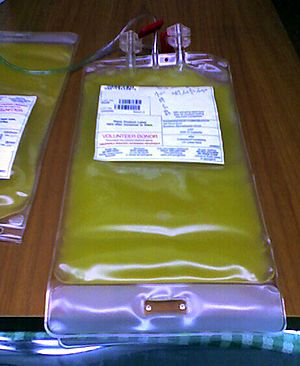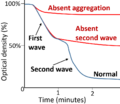Platelet facts for kids

A platelet is a tiny piece of a cell that floats around in your blood. Think of them as tiny helpers that stop bleeding. When you get a cut, platelets rush to the spot. They work together to form a blood clot, which is like a natural band-aid. This clot stops the bleeding and helps the cut heal.
If you don't have enough platelets, your blood might not clot well. This means you could bleed for a long time from even a small cut. On the other hand, having too many platelets can also be a problem. It can increase the risk of thrombosis, which is when blood clots form inside your blood vessels. These clots can block blood flow, which is very serious.
What Are Platelets Made Of?
Platelets are special because they don't have a cell nucleus. A nucleus is like the control center of most cells. Platelets are shaped like small, flat discs. They are very tiny, only about 1.5 to 3 micrometers wide. You can't see them without a powerful microscope!
Your body doesn't have a huge number of platelets at any one time. This means they can be used up quickly if you have a big injury. Inside each platelet are tiny storage sacs called granules. These granules hold different chemicals that are released when a platelet is needed. These chemicals help the platelet stick to other platelets and to the injured blood vessel, forming that important blood clot.
Images for kids
-
The ligands, shown as L, tell platelets (P) to go to a wound (Site A). As more platelets gather, they make more ligands to increase the response. Platelets gather to form a cap and stop blood from leaving the tissue.
-
A close-up view of blood cells. From left to right: a human red blood cell, an activated platelet, and a white blood cell.
-
This graph shows how platelets clump together in two stages, for example, when activated by ADP.
-
Platelets collected using a special machine called apheresis at an American Red Cross donation center.
See also
 In Spanish: Plaqueta para niños
In Spanish: Plaqueta para niños









